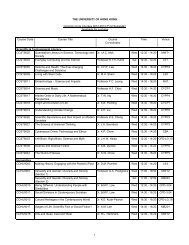handbook - HKU Common Core Curriculum - The University of Hong ...
handbook - HKU Common Core Curriculum - The University of Hong ...
handbook - HKU Common Core Curriculum - The University of Hong ...
Create successful ePaper yourself
Turn your PDF publications into a flip-book with our unique Google optimized e-Paper software.
Scientific & Technological Literacy<br />
Course Code // CCST9024<br />
Required Reading<br />
Selected chapters from:<br />
Harrison, E. (2007). Blood cells for sale. Scientific American,<br />
297(5), 108-109.<br />
H<strong>of</strong>fbrand, A. V., Moss, P. A. H., & Pettit, J. E. (2006).<br />
Essential haematology (5th ed.). Malden, MA; Oxford:<br />
Blackwell.<br />
Kline, R. M. (2001). Whose blood is it, anyway? Scientific<br />
American, 284(4), 42.<br />
Netting, J. (1999). Viral gene screen. Scientific American,<br />
281(2), 31-32.<br />
Nucci, M. L., & Abuchowski, A. (1998). <strong>The</strong> search for blood<br />
substitutes. Scientific American, 278(2), 72-77.<br />
Porter, R. (2003). Blood and guts: A short history <strong>of</strong> medicine.<br />
London: Penguin Books.<br />
Starr, D. P. (1998). Blood: An epic history <strong>of</strong> medicine and<br />
commerce (1st ed.). New York: Alfred A. Knopf. [Also<br />
available from Scientific American]<br />
Study Load<br />
Activities Number <strong>of</strong> hours<br />
Lectures 24<br />
Problem-based Learning tutorials 12<br />
Fieldwork/ Visits 5<br />
Reading / Self-study 40<br />
Practicals 4<br />
Films and videos 5<br />
Assessment: Essay / Report writing 24<br />
Assessment: Field work visit report 6<br />
Total: 120<br />
Assessment: 100% coursework<br />
Assessment Tasks Weighting<br />
Short essays 30<br />
Practical quiz and worksheet 10<br />
Field trip presentation 20<br />
Participation in Problem-based Learning<br />
tutorials 10<br />
Problem-based Learning portfolio 30<br />
Blood, Beliefs, Biology<br />
Course Learning Outcomes<br />
On completing the course, students will be able to:<br />
1. Explain how scientific discoveries and technolgoical<br />
innovations shape our understanding<br />
<strong>of</strong> blood, its biological properties and potential<br />
uses.<br />
2. Discuss how blood maintains our body in<br />
health, and describe why transfusions <strong>of</strong> blood<br />
and its products have been viewed to bring both<br />
benefit and harm to human beings.<br />
3. Demonstrate understanding <strong>of</strong> how cultural<br />
and personal beliefs shape engagement with<br />
blood through rituals, ceremonies, and in films<br />
and stories associated with vampirism.<br />
4. Articulate how science is distinct from, and<br />
connected with, other areas <strong>of</strong> investigation<br />
in the humanities, the social sciences, and in<br />
everyday life.<br />
Lecture Time // Second semester (Wed)<br />
This course will enable students<br />
to understand the reasons for the<br />
fascination which blood holds<br />
over human beings from a number<br />
<strong>of</strong> different, but interrelated,<br />
perspectives. <strong>The</strong>y will be able to<br />
articulate how our views <strong>of</strong> blood<br />
are not only changed in time<br />
through scientific discoveries<br />
and technological innovations,<br />
but are also affected by cultural<br />
and religious beliefs. Under the<br />
theme “Nature and Methods <strong>of</strong><br />
Science,” the course will address<br />
the historical understanding <strong>of</strong><br />
blood and its function viewed<br />
from both a western perspective<br />
as driven by scientific discoveries<br />
and from the traditional Chinese<br />
concept <strong>of</strong> blood and its relationship<br />
to qi. Under the themes “Science,<br />
Technology and Society”<br />
and “Science and Technology in<br />
Everyday Life,” the student will<br />
understand how advances in science<br />
coupled with innovations in<br />
technology have expanded the uses <strong>of</strong> blood e.g. blood banks (and the need for screening<br />
for infectious agents), blood as source <strong>of</strong> stem cells, and blood tests in forensic<br />
and legal medicine. Finally, the course will examine the meanings which blood bring<br />
through cultural and religious beliefs e.g. the role <strong>of</strong> blood in sacrifice and rituals; the<br />
prohibition <strong>of</strong> transfusion <strong>of</strong> blood by Jehovah’s Witnesses, the global fascination with<br />
taking and giving <strong>of</strong> blood in vampirism and its association with immortality.<br />
Course Co-ordinator<br />
Pr<strong>of</strong>essor L.C. Chan<br />
Department <strong>of</strong> Pathology,<br />
Li Ka Shing Faculty <strong>of</strong> Medicine<br />
Tel: 2255 4872<br />
Email: chanlc@pathology.hku.hk<br />
Teacher(s):<br />
Pr<strong>of</strong>essor L.C. Chan<br />
Department <strong>of</strong> Pathology,<br />
Li Ka Shing Faculty <strong>of</strong> Medicine<br />
Tel: 2255 4872<br />
Email: chanlc@pathology.hku.hk<br />
Dr J.C.C. So<br />
Department <strong>of</strong> Pathology,<br />
Li Ka Shing Faculty <strong>of</strong> Medicine<br />
Tel: 2255 4570<br />
Email: scc@pathology.hku.hk<br />
Dr S.L. Beh<br />
Department <strong>of</strong> Pathology,<br />
Li Ka Shing Faculty <strong>of</strong> Medicine<br />
Tel: 2255 4863<br />
Email: philipbeh@pathology.hku.hk<br />
http://commoncore.hku.hk/ccst9024<br />
47



